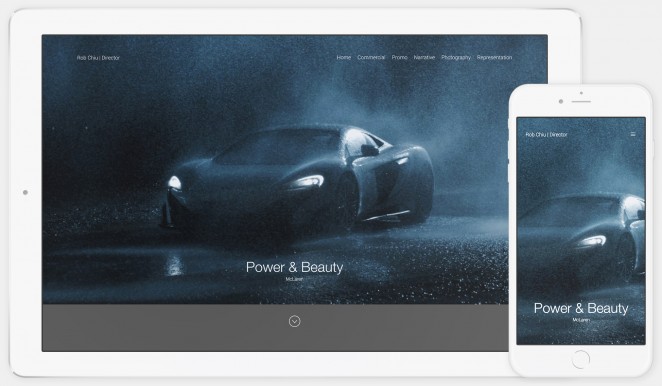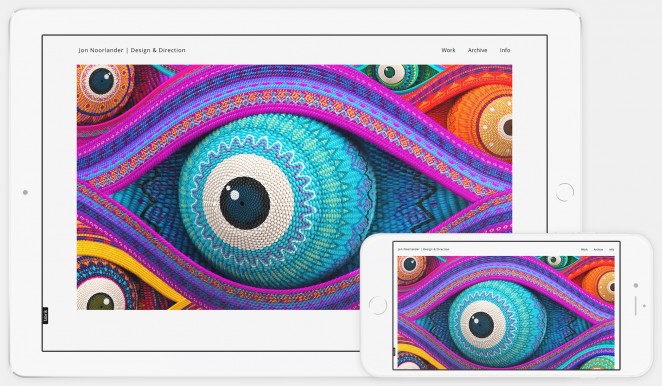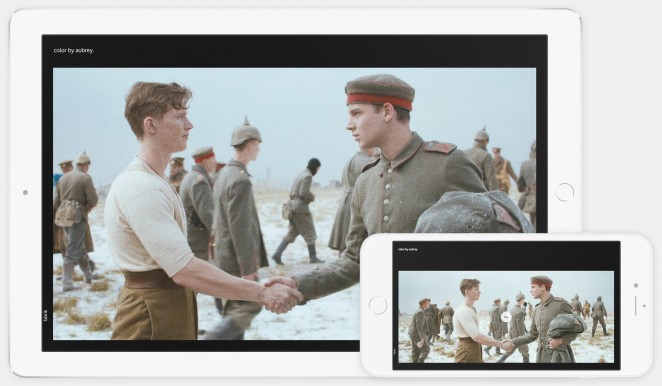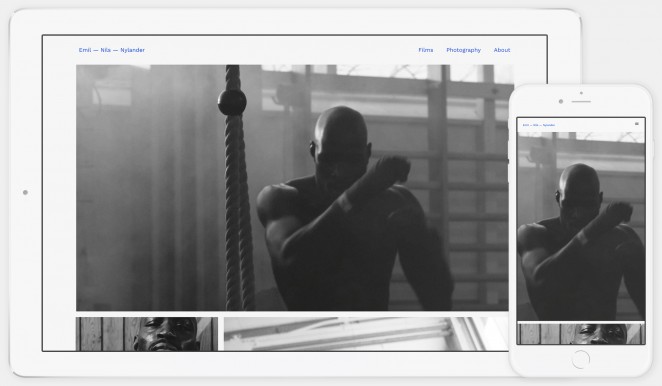Three guys got lucky with a nomination for their startup; Fabrik at this year’s Webby Awards next to industry giants Squarespace and Adobe.
This short guide explains how they got this far and why you should back the little guys. Help them celebrate the tiny possibility of clutching a People’s Voice award against such overwhelming odds. Ridiculously outgunned, you’re their only hope.
—————

Rob Chiu — McLaren: Power & Beauty
Competition
“Competition brings out the best in products and the worst in men.” [1]
Successful products and services thrive under competitive pressure. Instead of viewing competition as an obstacle, it can be a fantastic opportunity. For us, as a startup with a small team, the bar has already been set by some of the most progressive tech companies operating on the internet, which shows us exactly what our potential customers expect from us. To compete we need to match those expectations and exceed them. When the number of employees in those companies outnumber us more than 100 to one, we’re forced to prioritise and foster our energy as much as we can.
Competitors within a marketplace will consistently aim to offer better customer service, product quality and marketing as a way of adding value to new and existing customers. In healthy markets customers can demand the best solutions for their specific needs. Closely monitoring how your competition is progressing (although often disheartening) ensures you’re able to differentiate your offering to create value for your users.
If your industry is dominated by a sole supplier then innovation generally becomes less of a priority, simply because demand no longer forces it. Priority tends to shift from innovation to maintenance. With a fresher platform and only a few decision-makers you’ll be working leaner and you’ll be more focussed on solutions than margins — use this to your advantage; disrupt.
Within your marketplace progress comes when you either begin to keep pace with your competition, or you’re travelling so far away from them that people begin to notice you. From that point you’re a threat.
—————

Ninian Doff — Miike Snow: Genghis Khan
Passion
“Anything that gets your blood racing is probably worth doing.” [2]
Short of major physical trauma there is literally no way to stop three dogmatic, opinionated individuals from chasing their dreams. At least for a while.
“Startups come down to pure execution of a strategy on a daily basis and maintaining the faith for the long haul. Most startups don’t lose to competition, but because they lose the will to fight.”
— Dharmesh Shah, co-founder of HubSpot
Maintaining energy and focus with limited runway and an exhaustive workload is hard, so keeping your passion for progress as an individual and as a team becomes very important. Accept failure as a part of your workflow; learning to experiment and measure is crucial to your success, but understand that the outcome of experimenting is making mistakes quickly and recovering from them. It is possible to be too averse to risk, too scared, or (financially or technically) unable to make mistakes. Fail fast, fail often as they saying goes, but acknowledge that no member of your team is above error — keep personality and blame out of your recoveries.
Constant, close communication between your team becomes a way you maintain your original fire. If you can find a workspace where you can close the door and make enough noise to keep that energy flowing take it. We chose to join a co-working community of tech startups — which has its advantages in socially supporting a startup, but working in close, noiseless, proximity to other entrepreneurs means (for reasons of courtesy) you can’t easily vent, or show your excitement.
—————

Jon Noorlander — Ford: By Design
Experiment
“All progress is experimental.” [3]
Build, measure, learn. The basic, unequivocal feedback loop of the Lean Startup methodology. It allows us a recognisable path from nothing to something — the minimum viable product. The goal of an MVP is not to build a limited version of your product, it’s to get the most learning out of the least amount of effort. whatever experimentation and understanding you can do before committing to development the better. Before you gain your own community learn from the communities closest to the one you want to create, and those associated with other products you recognise as being similar to yours in their own markets.
Alternatives to a limited product as an MVP include video, landing pages and learning prototypes — these are exercises in validating your ideas and decision-making, normally to a small control group. The less your control group knows you personally, the better — you’ll get more honest and objective results, and make sure they represent the needs and habits of your intended users.
As you progress further through your development path from your MVP you’ll continue to iterate, experiment and measure — nobody has remained closer to the product you’re trying to create (and the problem you’re trying to solve) than you — so you’ll continue to form ideas and options from your gut, but you’ll also be using your users as guidance for your roadmap. We’ll discuss how you work with your users in the Listen section of this post, but the lean process doesn’t end; instead it becomes both more subtle and further-reaching in it’s execution.
Simple and quick solutions are valuable to a startup that is strapped for cash and energy, so think small to begin with. At Fabrik we made small updates to the way our users added video to their projects. Vimeo embedding in Fabrik began as a simple text field to embed a video directly into a project. We realised that most of our users were then also copying their project’s title and descriptions out of Vimeo, so we extended our functionality to take the same embed code, but to bring in their project title, cover image, tags and descriptive content from Vimeo too. What originated as a text field ended up being a major reason people used our platform.
As your product becomes useful your experiments will start to focus on retention as well as adding value. If you can afford to scale your experiments and expectations as your product and users grow you should take this approach — until then adapt.
—————

Ben Fordesman — FKA Twigs: M3ll155x
Adapt
“To bend like a reed in the wind — that is real strength.” [4]
Shifting and shuffling are much easier for small teams with simple and fresh products. Pivoting doesn’t need to be major and it doesn’t need to be permanent. Raindrops falling on a windowpane don’t always run down straight. As a drop rolls down there is an increase in the surface area. Creating more surface area needs additional work. If another drop has already preceded it, this additional work is not necessary and water takes the path of least resistance.
Early on, we found that most Fabrik users were filmmakers, but filmmakers are by far the smallest group of creatives. By having already added their content to sites like Vimeo they’d already made a lot of decisions about the work they wanted to present. We’d inadvertently made it very easy for them to create a portfolio site by leveraging the effort they’d already made elsewhere, something that no other portfolio platform was doing at that point. So we decided to focus on this and reduce friction for filmmakers even further. Now a filmmaker can create an entire portfolio in just a couple of minutes — adding their work from Vimeo or Youtube, choosing colour, theme and layout presets — making decisions on how their portfolio looks instantly without affecting their content at all.
We found that by gearing the portfolio creation process to be more playful, and by avoiding blank portfolio sites, our trial users didn’t get stuck and lose interest. They were finding value in our platform much faster. We continue to iterate using this approach we’re working on extending the same experience to creatives across other disciplines that have their work in other places too.
In designing a product people want to use you have to manufacture desire, especially if you’re entering a marketplace where your users are already served by competent products or services. There are plenty of good articles on how to manufacture desire, but this is an imperative part of your development process from MVP to MDP to a desirable product your potential customers want to be a part of.
At this point your branding and marketing begin to play a part in the way your product or service is accepted in its marketplace. Before your potential users get to you they’ll have formed an idea of you from wherever they came to you from. Your brand is not your logo — it’s the bridge between what your next user is doing right now and them using your product. The way you talk, and the way they listen, are the cornerstones of branding. Branding takes time, you’re fighting to establish your place in a market or an industry that maybe doesn’t need you, or at least doesn’t know they need you. It’s an evolutionary process, but you need to have a clear understanding of who you’re branding to and you need to stick to it. Marketing your startup enters the equation at this point — and it’s one of the hardest things to get right.
Understanding the basic traction channels of a modern product will help guide you, and you can use a familiar methodology of experimenting and learning to discover what works and what doesn’t. Marketing costs money. As you scale your reach to gain traction you need to understand that spending on marketing is a risk that needs to scale too.
“What we have been observing over the last few years is a lot of entrepreneurs who haven’t worked in a company that has had a large sales & marketing engine, and haven’t actually seen what that means, — basically if left to their own devices, they would never do it… and you get things like “sales is bad”… and the Lean Startup theory can get used as a crutch to not go do all that stuff. And typically what happens is the entrepreneur learns the hard way. They build the better mouse trap and the world doesn’t beat a path to their door, so they learn the hard way that it’s not going to work without going to the market hard at some point.”
— Marc Andreessen, partner at Andreessen Horowitz
A lot of tech companies are focussed entirely on growth rather than return — and the companies behind most big tech products you use day-to-day are spending every penny invested in them to make sure more and more people find out about them. This sort of reach is all but impossible to replicate without marketing spend. Infact you’ve got one option; build a community.
—————

Aubrey Woodiwiss — Sainsburys: Christmas is for sharing
Community
“Alone we are smart but together we are brilliant.” [5]
It’s better to have a thousand little guys in your corner than one really big guy, because each of those little guys can play a part in making sure you succeed. If you’re not geeky enough to know what a zerg rush is, google it, but you’ll see my point.
You’ve got the passion box ticked, you know how build, measure, learn and adapt. You’re competent at this, but you need some help. Building a community is where you get the chance to carve out a slice of the marketplace you’ve squeezed yourself into.
Have a mission early, and make it an honest one. Hopefully you didn’t start this whole journey for the cash because hell that’s a (very tenuous) reward, not a reason. You’re here because you saw something that could be bettered or improved, and you think you’re the person to make that happen. Involve your supporters and users on that journey, make them part of the process. Like your brand, a mission is better when it’s shared.
Our mission is simple; to enable, support and celebrate extraordinary talent with simple tools that make a big impact. That’s what’s written at the bottom of this page in the About Fabrik link. We’re working within a community we know and love and we’re pretty serious about giving each and every one of our users a platform from which they can find the recognition they deserve for the effort they put into their craft. We’re working on new tools that encourage our users to support each other, find work and remain motivated to keep creating.
When your users can see the value in what you’re doing they’ll champion it. By listening to them and exceeding their expectations you’ll keep them.
—————

Charlie Crane — Caritas: Keys of hope
Listen
“Wherever your focus is directed, that’s where your energy goes.” [6]
When working with a small community of engaged users you must take the opportunity to fully understand what they want from your product or service. Opinions and suggestions will differ, but this is an invaluable and key component in developing an efficient and rewarding solution to whatever problem you’re solving. An ongoing dialogue with your users makes them feel connected to what you’re doing, involved in shaping it’s future and it can be a powerful factor in the growth and recognition of your brand.
You’re probably adopting a user-centered design approach, so continued contact with your early users will greatly help you measure the effectiveness of both iterative, and new development in a way you can cope with.
We use Intercom to manage communication with our users from the first time they log into their Fabrik dashboard. A friendly welcome and introduction to our support personnel opens the message with an offer to help with any queries or requests they may have. The whole team has access to support, meaning we can all monitor requests coming in, and answer them promptly. In-app communication create a slick dialogue experience for the user and encourages them to speak more conversationally with us about their expectations and issues.
Features suggested by our users are logged in Trello against a tally scoring system to give them priority.
—————

Emil Nils Nylander — Nocco
Prove
“Luck is what happens when preparation meets opportunity.” [7]
We’ve managed to create a beautiful product and a growing community between the three of us, but we have a long way to go and we absolutely need your voice to help us get there. We need the exposure that goes with winning a Webby to show the internet we’ve arrived and that we’re serious about what we’re doing. Let us show you what we’re made of.
Give us your vote and help us prove that the little guys can make a big difference…
—————
About Fabrik
Designed especially for creatives, Fabrik is the quickest and easiest way to make a beautiful online portfolio. Born out of London’s film and design industries Fabrik’s mission is to enable, support and celebrate extraordinary talent with simple tools that make a big impact.
Quotes:
[1] David Sarnoff
[2] Hunter S. Thomson
[3] John Jay Chapman
[4] Lao Tzu
[5] Steven Anderson
[6] Anon
[7] Seneca






